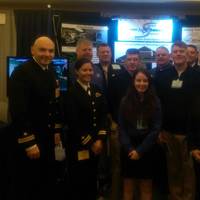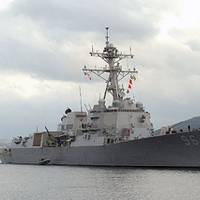CSCS Educates at the SNA Symposium

Representatives from the Center for Surface Combat Systems (CSCS) educated the surface warfare community on who they train and how they support the Fleet at the Surface Navy Association (SNA) Symposium January 12-14. Capt. Bill McKinley, CSCS commanding officer, oversees 14 learning sites and is responsible for combat systems training across the rates of fire controlman, operations specialist, gunner’s mate, sonar technician surface, mineman, interior communications electrician, and electronics technician.
Navy Prepares Remote Minehunting System as Future Asset
The Navy completed technical evaluation and training of the Remote Minehunting System (RMS) aboard USS Bainbridge (DDG-96) in Panama City on July 28. The evaluation enables the Navy to continue training on the system, designed as part of the mine warfare mission package for the littoral combat ship. "This is all in preparation for the operational evaluation (OPEVAL) to be conducted in the South Florida Test Facility this September," said Naval Surface Warfare Center Panama City RMS Project Engineer Keith Hartless. Senior Chief Mineman Paul King of the Littoral Combat Ship (LCS) Mine Countermeasure (MCM) Detachment 1 praised RMS as cutting-edge technology during his pierside preparations. "This is the future in the making," said King.
Navy Evaluates Remote Minehunting System

The Navy completed technical evaluation and training of the remote minehunting system (RMS) aboard USS Bainbridge (DDG-96) in July 28. The evaluation enables the Navy to continue training on the system, designed as part of the mine warfare mission package for the Littoral Combat Ship. "This is all in preparation for the operational evaluation (OPEVAL) to be conducted in the South Florida Test Facility this September," said Naval Surface Warfare Center Panama City RMS Project Engineer Keith Hartless.
APS Aboard HSV Swift Visits Togo

The high-speed vessel (HSV 2) Swift is moored pier-side at Naval Amphibious Base Little Creek before departing for the western coast of Africa. While in Africa, Swift will take part in the Global Fleet Station (GFS), Africa Partnership Station (APS) Initiative, for the purpose of strengthening cooperative partnerships with regional maritime security. U.S. Africa Partnership Station (APS) pulled into Lome, aboard High Speed Vessel (HSV) 2 Swift Jan. 28, as the first U.S. Navy ship to visit Togo in 15 years.
HSV Swift Repairs PIRATA Buoy

The high-speed vessel (HSV 2) Swift is moored pier-side at Naval Amphibious Base Little Creek before departing for the western coast of Africa. While in Africa, Swift will take part in the Global Fleet Station (GFS), Africa Partnership Station (APS) Initiative, for the purpose of strengthening cooperative partnerships with regional maritime security. U.S. Sailors aboard High Speed Vessel (HSV) 2 Swift repaired a Pilot Research Moored Array in the Atlantic (PIRATA) buoy, Jan. 25…
High Speed Vessel Shows RIMPAC the Future

The Navy's newest experimental ship sailed into Pearl Harbor July 5 to participate in the Rim of the Pacific (RIMPAC) 2004 exercise. Of the 40 ships in RIMPAC, this ship stands out as unique. The High Speed Vessel Swift (HSV) 2 is a 321-foot catamaran drawing only 11 feet of draft, with a top speed of almost 50 knots powered by its four swivel water jets. According to Chief Mineman Paul Bertsch, Swift's engineering department head, HSV's primary focus during RIMPAC will be mine counter-measures, to include deploying divers and underwater robotic vehicles to seek out and disarm mines.
Global Fleet Station Deployment Begins
High Speed Vessel (HSV) 2 Swift, along with Commander Task Group 40.9, is deploying as part of the Global Fleet Station (GFS) pilot to the Caribbean Basin and Central America. This deployment is designed to analyze the GFS concept for the Navy, by enhancing cooperative partnerships with regional maritime services and improving operational readiness for the participating partner nations. U.S. The pilot Global Fleet Station (GFS) deployment began April 25, with the departure of High Speed Vessel (HSV) 2 Swift and the embarked Task Group (TG) 40.9, from Naval Station Mayport. “After much anticipation and preparation it feels great to get underway,” said Capt. Douglas Wied, commander Task Group 40.9. Global Fleet Station pilot 2007 is a U.S.
SURFLANT Tours MCM CLASSRON, Ships
Commander Naval Surface Force U.S. Atlantic Fleet (SURFLANT) toured two mine warfare class squadron’s mine countermeasures ships March 5 to evaluate the progress of the alignment of existing waterfront and type command organizations. Rear Adm. D.C. Curtis, SURFLANT, said he prefers to get out from behind his desk and visit his commands. “It’s the best way to get to know your Sailors, the ships, the needs,” he said. To strengthen surface forces and streamline costs, the Surface Warfare Enterprise formed eight class squadron (CLASSRON) implementation teams. Four of the eight CLASSRONs began operations Feb. 15 and will handle training, maintenance, personnel and logistics for ships by class. Capt.





